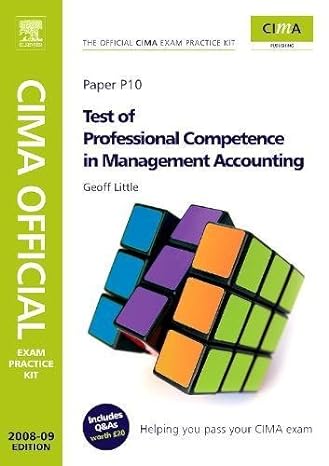Question
Multiple Choice Select the best answer to each question. Space is provided for computations after the quantitative questions. ____ 1. (CPA) The Forming Department is
Multiple Choice
Select the best answer to each question. Space is provided for computations after the quantitative questions.
____ 1. (CPA) The Forming Department is the first of a two-stage production process. Spoilage is detected at the end of the Forming Department. Costs of spoiled units are assigned to units completed and transferred to the second department in the period spoilage is detected. The following information concerns Formings conversion costs in May 2011:
Units
Conv. Costs
Beginning work in process (50% complete)
2,000
$10,000
Units started during May
8,000
75,500
Spoilagenormal
500
Units completed and transferred out
7,000
Ending work in process (80% complete)
2,500
Using the weighted-average method, how much of Formings conversion costs were transferred to the second production department?
a. $59,850
b. $64,125
c. $67,500
d. $71,250
____ 2. Using the information in question 1 and the FIFO method, how much of the Forming Departments conversion costs were transferred to the second production department? (Round equivalent unit cost to four decimal places.)
a. $58,853
b. $66,618
c. $67,735
d. $69,603
___3. (CMA) During March of the current fiscal year, Mercer Company completed 50,000 units costing $600,000, exclusive of spoilage allocation. Of these completed units, 25,000 were sold during the month. An additional 10,000 units, costing $80,000, are 50% complete at March 31. The inspection point is at the end of the production process. For the month, normal spoilage is $20,000 and abnormal spoilage is $50,000. The portion of total spoilage costs that should be charged against revenues in March is:
a. $50,000.
b. $20,000.
c. $70,000.
d. $60,000.
e. $30,000.
____ 4. If spoilage occurs that is normal and Control should be credited with:
a. nothing.
b. the disposal value of the spoiled goods.
c. the net spoilage cost.
d. the gross spoilage cost.
____ 5. In a job-costing system, Work-in-Process Control should be debited with the cost of rework that is:
a. abnormal.
b. normal and common to all jobs.
c. normal and attributable to a specific job.
d. discarded.
____ 6. (CPA) Simpson Company manufactures electric drills to the exacting specifications of various customers. During April, Job 403 for the production of 1,100 drills is completed at the following cost per unit:
Direct materials
$10
Direct manufacturing labor
8
Manufacturing overhead allocated
12
Total manufacturing cost
$30
Final inspection of Job 403 discloses 50 defective units and 100 units of normal spoilage attributable to this specific job. The defective drills are reworked at a total cost of $500 and the spoiled drills are sold to a jobber for $1,500. What is the unit cost of the good units produced on Job 403?
a. $33
b. $32
c. $30
d. $29
___ 7. (CPA) Under Heller Companys job-costing system, the budgeted manufacturing overhead cost rate includes the estimated costs of defective work (considered normal in the manufacturing process). During March, Job No. 210 for 2,000 hand saws is completed at the following cost per unit:
Direct materials
$ 5
Direct manufacturing labor
4
Manufacturing overhead allocated (at 150% of direct manufacturing labor cost)
6
Total manufacturing cost
$15
Final inspection of Job No. 210 discloses 100 defective saws were reworked at a cost of $2 per unit for direct manufacturing labor, plus manufacturing overhead at the budgeted cost rate. The defective units on Job No. 210 are considered normal. What is the total rework cost and to which account should it be debited?
Rework cost
Account debited
a.
$200
Work-in-Process Control
b.
$200
Manuf. OH Control
c.
$500
Work-in-Process Control
d.
$500
Manuf. OH Control
____ 8. (CPA adapted) If the value of scrap is not immaterial, the scrap is sold soon after its production, and the scrap is common to all jobs in a manufacturing process, the scrap is recorded as a:
a. credit to Manufacturing Overhead Control.
b. debit to Manufacturing Overhead Control.
c. credit to Finished Goods Control.
d. credit to Work-in-Process Control.
Step by Step Solution
There are 3 Steps involved in it
Step: 1

Get Instant Access to Expert-Tailored Solutions
See step-by-step solutions with expert insights and AI powered tools for academic success
Step: 2

Step: 3

Ace Your Homework with AI
Get the answers you need in no time with our AI-driven, step-by-step assistance
Get Started


